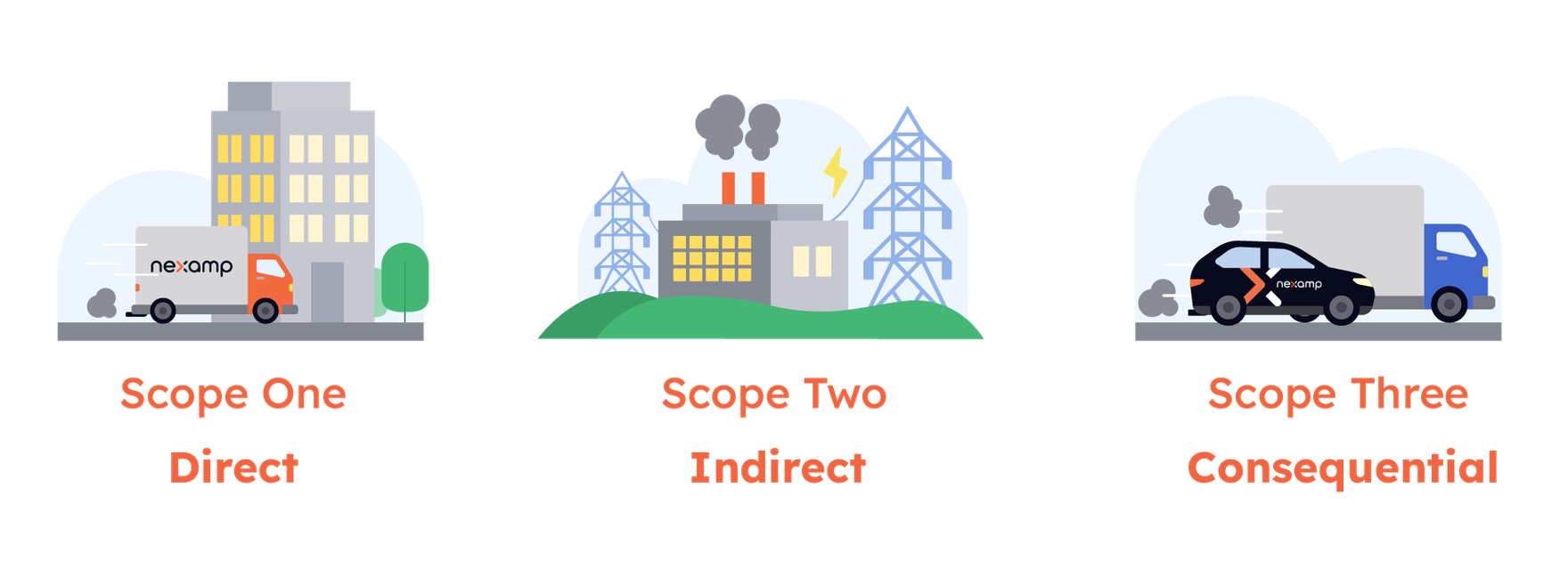
Nexamp has a reputation – top solar asset owner, the largest owner-operator of community solar, and our nation’s number-one distributor of clean energy. With the goal of a completely transformed electricity grid in mind, we’re well on our way to home plate. However, as the Paris Agreement clearly states, it's fewer emissions that Earth really needs. So, in 2020, we started honing in on Nexamp’s carbon footprint, and I’m proud to share where we are today.
CALCULATING NEXAMP’S CARBON FOOTPRINT
A carbon footprint is broken into three categories: direct (scope one), indirect (scope two), and consequential emissions (scope three).
Direct: Emissions we control, such as gas used in company vehicles and power used in offices.
Indirect: The emissions created while the power we use is produced.
Consequential: The associated emissions of our supply chain and employee travel.

To calculate our carbon footprint, we had a Supply Chain team member attend the Greenhouse Gas Institute while Melissa Rath, former senior design engineer, and Jarrod Sonett, business development manager, researched carbon coefficients and analyzed our supply chain, extracting quantities and shipping routes.
Three years after the implementation of our emission-reduction strategy, we’re confidently tracking Nexamp’s carbon footprint at the project level. The carbon payback of each project is also considered, which is the amount of time it takes for a renewable energy project to offset the emissions created during its construction. This, of course, applies to all Nexamp projects. Even still, we know it’s not enough. The climate crisis is demanding urgency – reductions today, not tomorrow. So, we knew right away that the focus of the second phase of our footprint audit should be reduction.
REDUCING NEXAMP’S CARBON FOOTPRINT
You may have seen our recycling plan, but that’s not all we’re doing to lower emissions. Dedicated team members have ensured that 49 Nexamp community solar farms are certified wildlife habitats, 27 sites are dedicated pollinator habitats, and 31 sites are leveraging agrivoltaics. Local shepherds are also helping Nexamp lower land maintenance emissions with sheep grazing. Beyond biodiversity, the task of transitioning our entire fleet to electric vehicles is well underway. So far, we have 9 Mach-E Mustangs, 5 Tesla Model Ys, and 7 Hybrid Ford Escapes. This is what we’re doing onsite to reduce Nexamp’s scope one and two emissions. But as most of you know, scope three makes up the majority.
To lower these emissions, we’ve started the process of onshoring Nexamp’s supply chain, which incidentally has put us in a great position to take full advantage of the 10% domestic content adder included in the IRA (Inflation Reduction Act). Clearly, sustainable efforts can lead to financial gains. And considering the recent reports flagging that global warming will likely surpass 1.5ºC within the next five years, ignoring climate change is actually a liability. Take what’s happening in New York, for instance. The state is proposing a Packaging Reduction and Recycling Infrastructure Act, which could delay the construction of renewable projects for companies without a waste management plan in place. As Nexamp implemented a recycling plan two years ago, zero of our farms will be affected. This isn’t the first time our planet-first approach has paid off, and it won’t be the last.
MOVING FORWARD
It’s too late for lofty ESG goals and carbon offsets. The climate is in a freefall, and it’s emission reductions that will really make a difference. So that’s what Nexamp is focused on – lightening our carbon footprint in the areas where we do business. Understanding it’s underserved and minority communities who are often hit the hardest, we’re locating the majority of our efforts in these areas.
I am proud to work at a company that’s putting Earth first, and to all Nexampers reading this, thank you! Your hard work is recognized, and these achievements wouldn’t have been possible without you. Let’s keep making decarbonization easier for future generations and start drawing the map toward net negative.